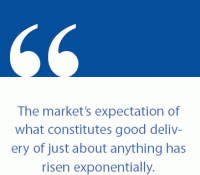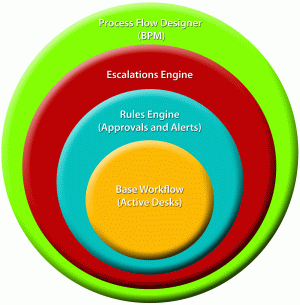Published on the 14/10/2009 | Written by Vendor

Greentree chief executive Peter Dickinson talks about how business process management can be a key tool in driving exceptional company performance – and the top ten BPM realities…
What’s the problem? Before looking at the world of automated BPM systems, and all the clever technology, we need to understand what the real world problem we are trying to solve is. What’s wrong with the world of a few good people, with maybe a bit of basic documentation about what to do and when? It’s the real world most of us have worked in; everyone’s got a brain, and the world hasn’t collapsed. But we need to do a modern-day reality check. Top 10 business process realities Reality No. 2: We are even worse at consistently doing well when it comes to more complex, multi-stage processes, particularly when there are different condition variations. Reality No. 3: Things really start to unravel when multiple people are involved in said multistage processes. Reality No. 4: New employees either screwup or, through paranoia about getting something wrong, start at a snail’s pace – or both. It’s not their fault as nobody has the time to really induct them regarding the skill and knowledge level required across typically many requirements. They flounder on as best they can, sometimes in parallel with the rapid update of the process manual, so “we don’t go through this again”. Reality No. 5: Most process manuals – if they exist – languish unloved, as no-one can be bothered putting in what is a significant amount of effort maintaining them when nobody uses them anyway. Reality No. 6: Whether it be personality disorders, anti-social tendencies, difficulty engaging with people not on the same wavelength or simply lack of time, human beings are fundamentally poor communicators. Most of us make way too many presumptions as to what others know, have done or have communicated. Reality No. 7: We may manage to communicate what’s going wrong or needs attention, but we’re generally hopeless at communicating positive confirmation – that is, what stage something is at, what’s been successfully completed, etc. Reality No. 8: People fear visibility and transparency of information, despite it being a critical ingredient of good business performance. Reality No. 9: Put an organisation and its people under workload stress – or experience really good growth – and watch the communication cracks turn into chasms. Reality No. 10: If you can’t relate to realities 1-9 then well done, but… either you’re spending a huge amount of time, effort and money managing these business challenges or you have fully automated BPM already. Alongside the flaws of just being human, the other critical reality is that the world is changing rapidly and that’s not going to slow down. A few examples: sales orders are no longer the domain of travelling sales reps but now come through the web, email, EDI, phone, etc. Service models have changed dramatically. Outsourcing, specialist contract suppliers, supply chains and inventory management have all been turned upside down. In addition, the market’s expectation of what constitutes good delivery of just about anything has risen exponentially. To be competitive and profitable, business models have had to change and that has meant more complexity, with more parties involved and lots of opportunities for unfortunate “gotchas”. How does BPM help? Consistency and control are obtained by, first, having a process defined; the appropriate people are then pulled in to the various steps in the process; all parties (internal and external) are communicated with, and there is total transparency regarding progress and/or bottlenecks. Simple examples include the steps and controls needed for the correct establishment of a new customer; the timely management of a sales order, with approval levels for discounting; or the approval of purchase orders. A classic example is management of a customer service request. Even in today’s highservice expectant market many companies’ service delivery is dependent on the individual responsiveness and communication ability of service technicians. From personal experience we all know how often that model breaks down. BPM, at low cost, allows you to proactively manage your service business, catch all the ‘gotchas’, using escalations, and automatically communicate with customers so they know you are on the ball. A Greentree customer example of this involves an air-conditioning company that is responsible for constant testing of rooftop systems for legionnaire’s disease. There are strict protocols in place for the management of results, and communication with health authorities, with significant consequences for getting it wrong. To cope with this, the BPM system schedules routine testing so no units get missed; monitors whether test results have been received within mandated timeframes; and, depending on results, communicates and escalates to the right parties, and monitors that the corrective actions have occurred. A small task automated, but a big perception improvement is the result, with a system that now automatically sends the customer the news of a clear result. This is a good example of a company fine-tuning and improving its processes at little additional cost, and something that is unlikely to be consistently delivered using a manual process system. Unfortunately, fraud and theft are prevalent in business. BPM can address this risk too, using the many easy controls it incorporates. From discount monitoring – tracking and notifying any changes to supplier bank account details or similar potentially suspicious activity – BPM has a strong auditing role to play too. Managing inconsistency Not all customers are equal; not every inventory item needs follow the same supply process; some machines (or people) need different kinds of monitoring. BPM’s capacity to handle all these variations provides business with the biggest boost from using a BPM system. A Greentree customer example of this involves a company that has hundreds of products and thousands of customers. But there is one specific range of products that goes to just one customer that provides 30 percent of the company’s profits. To miss deliveries, be out-of-stock or mess up this critical piece of business would see this customer quickly turn to other suppliers. So, for this one piece of business, the company has several specific BPM processes, management alerts and escalations – even to the CEO’s cell-phone. Every order that’s received is tracked; re-order processes are treated as unique and automated, and automatic status communication to the customer is built in at every stage. At minimal cost the company has built a bullet-proof process. BPM is not about creating a strait-jacket that buries the organisation in meaningless approvals and bureaucracy. It’s about really targeting the things that matter and making sure every person does them every time. Greentree’s BPM development The true power of Greentree’s BPM lies in its full integration with the Greentree applications. With third party/add-on products, the BPM technology is reliant on the underlying systems being programmed to notify a mass of information. So, you not only have the cost and complexity of setting up a specialised BPM system, with its own unique user interface, but the extra cost and complexity of mapping these systems to your other business systems, and constantly maintaining and extending this interface. Because the Greentree system is totally integrated it knows and understands all the data and the business transactions being undertaken, so it can intelligently see what has or hasn’t been done and what stage processes are at. For more information vist www.greentree.com …
Let’s try and cut through all the mumbo jumbo of BPM. Historically, it has been seen as the preserve of large companies and high-cost business consultants, who were adept at putting your business into a strait-jacket. But, with some of the tools available today, it is one of the key tools in driving exceptional business performance and increasing business returns.
Reality No. 1: Most human beings aren’t great at undertaking repetitive processes consistently well. Whether the problem’s boredom, pressure, distractions or other priorities, there will be cracks.
BPM gives you the opportunity to not only document your processes, but the ability to fully automate them, so you can deliver consistent, controlled results – no matter who is involved in the process – and the ability to improve and refine easily.
Consistency and control are seen as the key benefits of BPM, but, personally, I believe its greatest power is in managing inconsistency in all its variations.
Greentree’s development of BPM has been a multi-million dollar investment over the last five years. We have built a full BPM system that works across our entire product range. From financials to HR; from manufacturing to service management etc, it has a capability that can be used in any part of your business system. As per the onion diagram below, it has involved building many layers of technology.

































